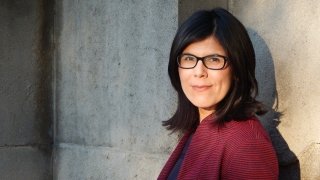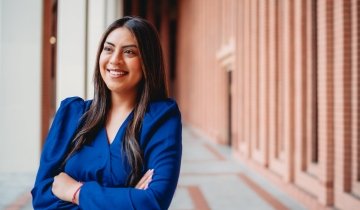Natalia Molina, a historian, award-winning author and Distinguished Professor of American Studies and Ethnicity at USC Dornsife College of Letters, Arts and Sciences, will deliver remarks at USC Rossier’s doctoral hooding ceremony on May 10. Molina’s work examines the historical roots of narratives about race and citizenship, how they shaped public policy and how they continue to play a role in today’s racial inequities. Much of her writing, which earned her a MacArthur Fellowship in 2020, also focuses on sharing the stories of the under-documented. Here, she discusses the art of the commencement speech, the importance of the humanities and offers advice to the Class of 2023.
As you prepared your remarks for USC Rossier’s doctoral ceremony, were there any commencement addresses that inspired you?
Commencement addresses mark the end of a journey. But actually, the speech that I remember best was from the beginning of a journey, when I was a freshman at UCLA. At orientation, they said, “Look to your left. Look to your right. One of those people won’t be there at graduation.” They were trying to emphasize how difficult this process is. But when I went through the orientation for students of color, they said, “Look to your left. Look to your right. Hold their hands and make sure they’re there at graduation.” And all these years later, I still remember that because I think that is the mentality we need to get through our programs and life.
What are the essential elements of a commencement address?
I imagine the commencement address as a Venn diagram, where I’m bringing myself, my life experience and my research, and I’m seeing where it lines up with not just where the graduates are at but where they’re going and their hopes of them feeling seen.
Recently I was listening to the remarks by President Biden marking the 25th anniversary of the Belfast Good Friday Agreement—and he was talking about George Mitchell, who was the American statesman who brokered that agreement. George Mitchell often said he had “700 days of failure and one day of success.” In a commencement speech, you’re trying to give a message of hope that maybe one of those days of failure—or challenges—will actually get them through to that day of success.
Commencement addresses often reflect on the unique challenges that today’s graduates face. What are some of the challenges that the Class of 2023 will face, particularly those working in education?
As we come out of the pandemic, many of us have seen challenges. But USC Rossier graduates are entering one of the fields that we most need now, and yet one that is most challenged. This has always been a difficult job, whether you’re an educator or a leader in education, and it’s even more daunting now as they lead into the unknown. Yet, that’s what makes it so exciting, right? You can use a crisis as an opportunity. You don’t have to do things like you’ve always done them. As much as the pandemic was challenging, it did away with these restraints that people said we could never do away with. It’s both a time of tremendous challenge and tremendous opportunity. The pandemic really showed us how adaptable and resilient we all are.
There has been a troubling decline in students majoring in the humanities. As a historian, does this concern you, and if it does, why does it?
I was in a public space and told somebody that my son had recently graduated with a BA in history, and that he was working in this field. Somebody overheard it, interrupted the conversation, and said, incredulously, “How is he using a history degree?” We have this sense that the humanities aren’t like other fields, where you take the skills you learn and apply them directly to the situation you’re in. People that major in humanities and social sciences are also thinking about social issues. They’re looking at examples of how we’ve done things in the past, or through novels, through fiction. They are asking how we can study this in other cultures, and see how we can make the world a better place. I hope we always have people doing that.
I don’t see it as a crisis in the humanities, but a scarcity crisis. People feel that they need to major in something they will use, and where they can readily imagine what that means. I get it! A lot of that started with the 2008 recession. As the cost of education has escalated so much, we tend to think, “What is our ROI?” But imagine how bankrupt we would be without these tools of imagination, tools that allow us to connect with one another, and imagine the journey of someone different than ourselves. That’s when we’re really talking about scarcity—when we can’t empathize.
You coined the term “racial scripts.” Can you tell us a little bit about what that means, and the importance of recognizing the deployment and redeployment of these scripts?
This dovetails nicely with what we’re talking about in terms of empathy. Racial scripts are essentially a way for us to see our experience in others. The usual way that we learn the experience of groups other than ourselves is in a series of silos. Traditionally, we learn about Latino studies, African American studies, Asian American studies and Indigenous studies separately. My theoretical framing and research unearth visible connections between these groups and also the more hidden links. Racial scripts highlight the ways in which the lives of racialized groups are linked across time and space, and thereby affect one another, even when those groups don’t directly cross paths. The central goal of racial scripts is to expose those connections.
Could you give us an example?
Because my first book focused on the way public health and science inform how we shape categories of race, I was called on to do a lot of consulting and interviews during the pandemic to shed light on anti-Asian racism. I was asked, “Are you surprised by this?” I wasn’t because we’ve seen anti-Asian racism in the past. We can trace it back into the late 1800s and the fact that the first anti-immigrant exclusion law was directed at Chinese immigrants, forward to Japanese internment camps and 100 other data points in between. But what if we look at the ways that other groups were racialized along the way? The forced sterilizations of Latinos here in our own LA County Hospital, the forced sterilizations of African American women, and the way that public health shaped border policy to make certain immigrants—including those that we consider White now, like Eastern Europeans—seem more susceptible to disease. If we broaden it in that way, we see that reinforcement of that othering is not just about a specific group, but various groups. The exclusion of one group serves to reinforce the exclusion more broadly.
Your most recent book A Place at the Nayarit, How a Mexican Restaurant Nourished a Community, traces the history and impact of your grandmother’s iconic Echo Park restaurant. You write about how places like this, urban anchors—neighborhood cafes and restaurants—were and are incredibly important to immigrant communities in Los Angeles. What do these spaces offer the marginalized?
We tend to think about public space as being the most democratic kind of space—that everybody has access to it. But we know by studying history that buses, public schools, beaches, schools—even if they’re public—aren’t always readily accessible to everyone. By turning to the semi-public spaces—what I call urban anchors, places that immigrants create for their own communities—people are able to find a sense of safety and recognition. When they go about their lives, especially working-class immigrants, they go around kind of in one dimension as a worker. But in these urban anchors, they can come into a space where they can unfold into three dimensions. They can speak their language, dress in clothes that they choose, enjoy good food, and enjoy that sense of connection and community. We see why these semi-public spaces, these urban anchors, are central to communities, especially as people are trying to gain a foothold in a new homeland. Think about when you go to a place, and then they have some kind of food that you grew up with, and you have that moment. Proust called it the madeleine moment. Urban anchors are a way of bringing home there.
With the gentrification of areas like Echo Park, what do you think is at stake as these Los Angeles neighborhoods change?
The impetus to tell this story at this time was that people kept suggesting that gentrification was bringing progress to an area that had no story or history of its own. The book is trying to show that, even if they don’t have a $9 latte, these places, with their immigrant place makers, establishing their urban anchors, were establishing a powerful sense of community. The book offers a kind of warning of what happens if we don’t actively work to tell the stories of these folks. If we don’t even see how they’re represented in their past, how are we going to see them, account for them and plan for them in the future?
The Latinx workforce that built the Huntington Library is the subject of your next book. How did you go about selecting this topic and why, in this forthcoming work and A Place at the Nayarit, have you chosen to focus on workers?
I’ve been going to the Huntington Library for over 25 years. And while it is a rich place to study in terms of the resources that they have and the community of scholars, when I first started going there, it could also be an alienating place for a woman of color. One of the times that I was there, I invited my dad—a Mexican immigrant—to have lunch with me. He was saying how beautiful the place was, and I said it can also be intimidating when you’re the only person of color in a reading room with 70 people. He leaned over and said, “Why would you ever be intimidated? We built this place.”
It was such a jolting reminder that we tend to tell the stories of certain institutions, of certain events, from the top down. As a historian, I’ve always worked to tell stories from what we call the bottom up, or the perspective of the community. Community histories can tell us so much about how people find space and belonging. And yet, for the Huntington, in our present I hadn't quite thought about it in those terms. For a long time, there were no archives to tell that story, and there still aren’t. But as a historian, I have 20 years of experience under my belt of using different tools to get at these little shards that can be pieced together to archive and build a story about the history of this well-known cultural institution, but from the perspective of the people who built it.
Looking back at your schooling, from kindergarten to your graduate studies, is there an educator who was particularly influential?
Do you know the story of Roger Bannister? When he was 25 years old, in 1954, he was able to break the 4-minute mile barrier. Nobody had broken it before. Once it was broken, 46 days later, somebody broke that barrier again. And then, a year later, three other runners broke that barrier in a single race. And so, to me, there’s something to be said about following in the footsteps of people who have broken those barriers.
I’m the 22nd Chicana to receive a PhD in U.S. History. That shows you how new we are to this field; how little we’ve been represented. But once you know that somebody did it, you can do it, too. It was the community of women who actually showed me the list of 21 Chicana PhDs that they had written down. And when I was a graduate student they told me, “You will be number 22.” And I thought, “Oh, how could I let them down?” There’s something in that, being part of the community, being seen. Sometimes we find it in one single educator, and sometimes we find it in a community.
USC Rossier’s doctoral students include leaders in education, business, government agencies, and nonprofit organizations. Despite the wide and varied next steps our graduates will make, achieving educational equity is at the center of their studies at USC Rossier, and so is addressing disparities that affect the historically marginalized. As these grads continue or enter new positions in their professional lives—often in leadership positions—what would you urge them to remember as they lead their respective organizations and make decisions that affect the workforces they manage?
I think the keyword there is lead. As a leader, you’re breaking new ground. When you’re breaking new ground, you’re not necessarily going to please everybody. And so, it’s remembering your why, which is based on your training, your education, and your life experience. When I’m faced with these situations, I think of Dr. Martin Luther King Jr., who was fighting not just for civil rights, but also against the Vietnam War, against economic disparity and for wage equity. Seventy-five percent of Americans disapproved of his viewpoints. If we look for approval on what we’re doing when we’re engaging in breaking new ground, that’s not always going to happen. Heavy is the head that wears the crown. When you’re a leader, that is part of the responsibility that you must shoulder.




